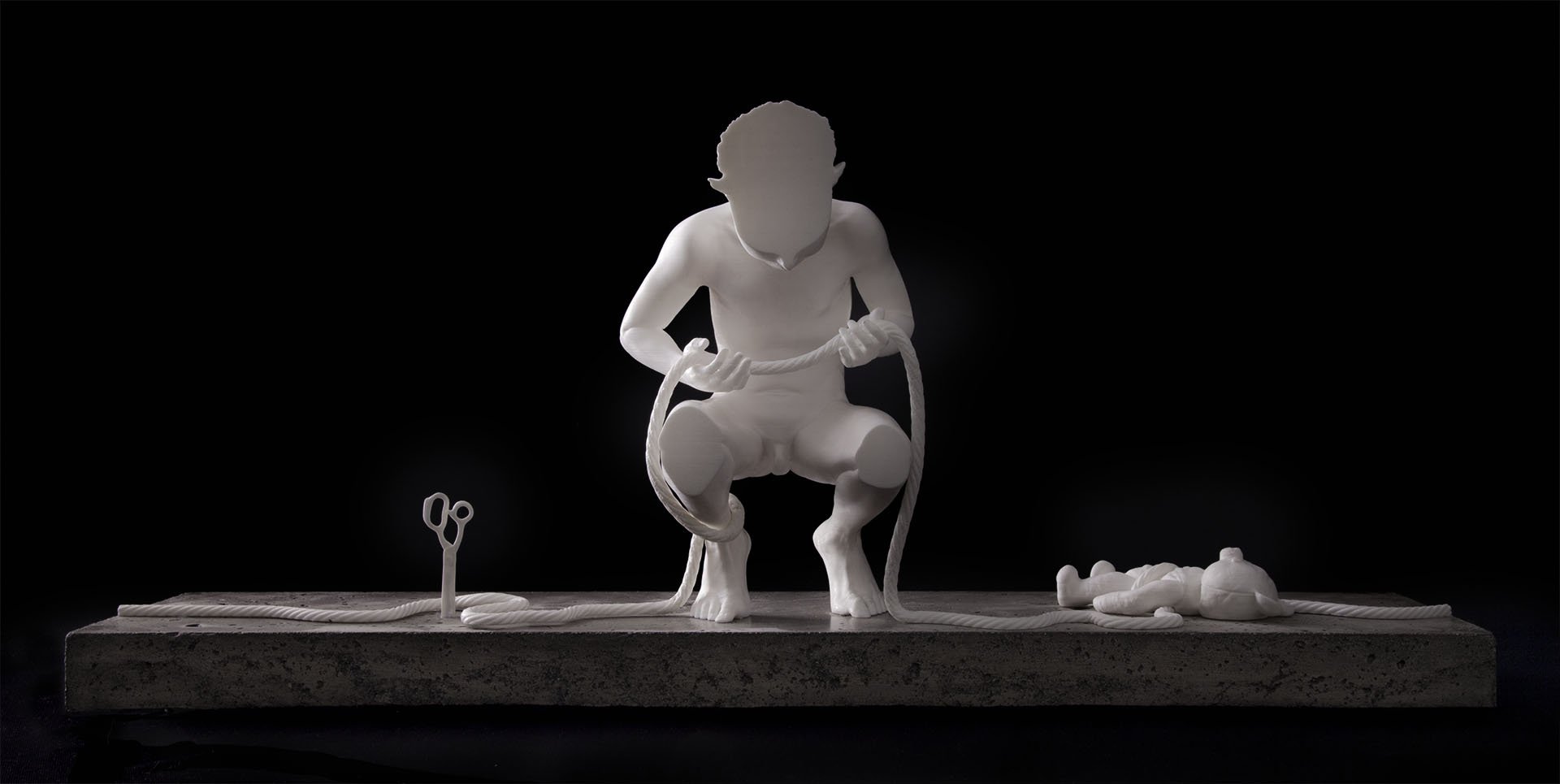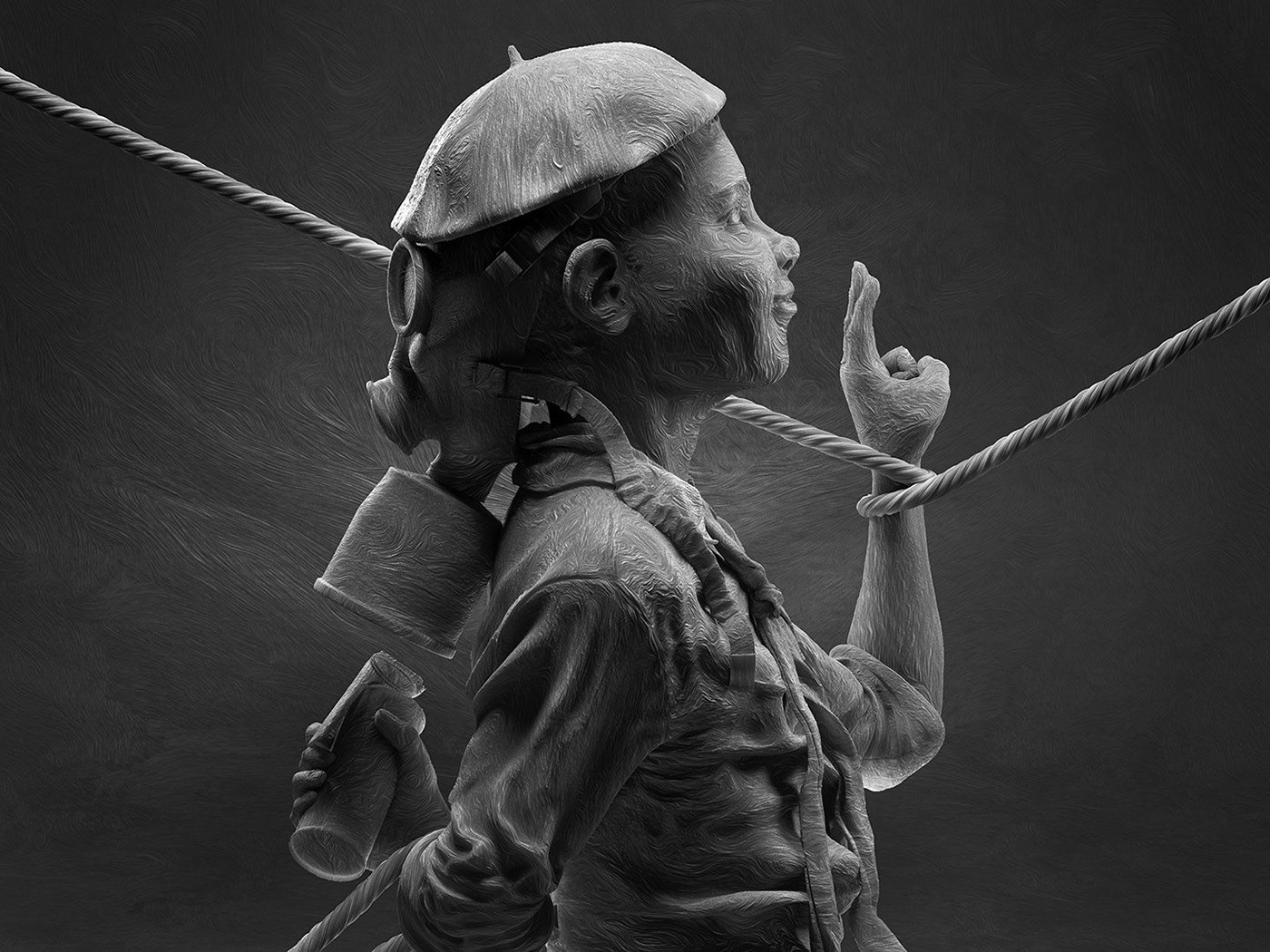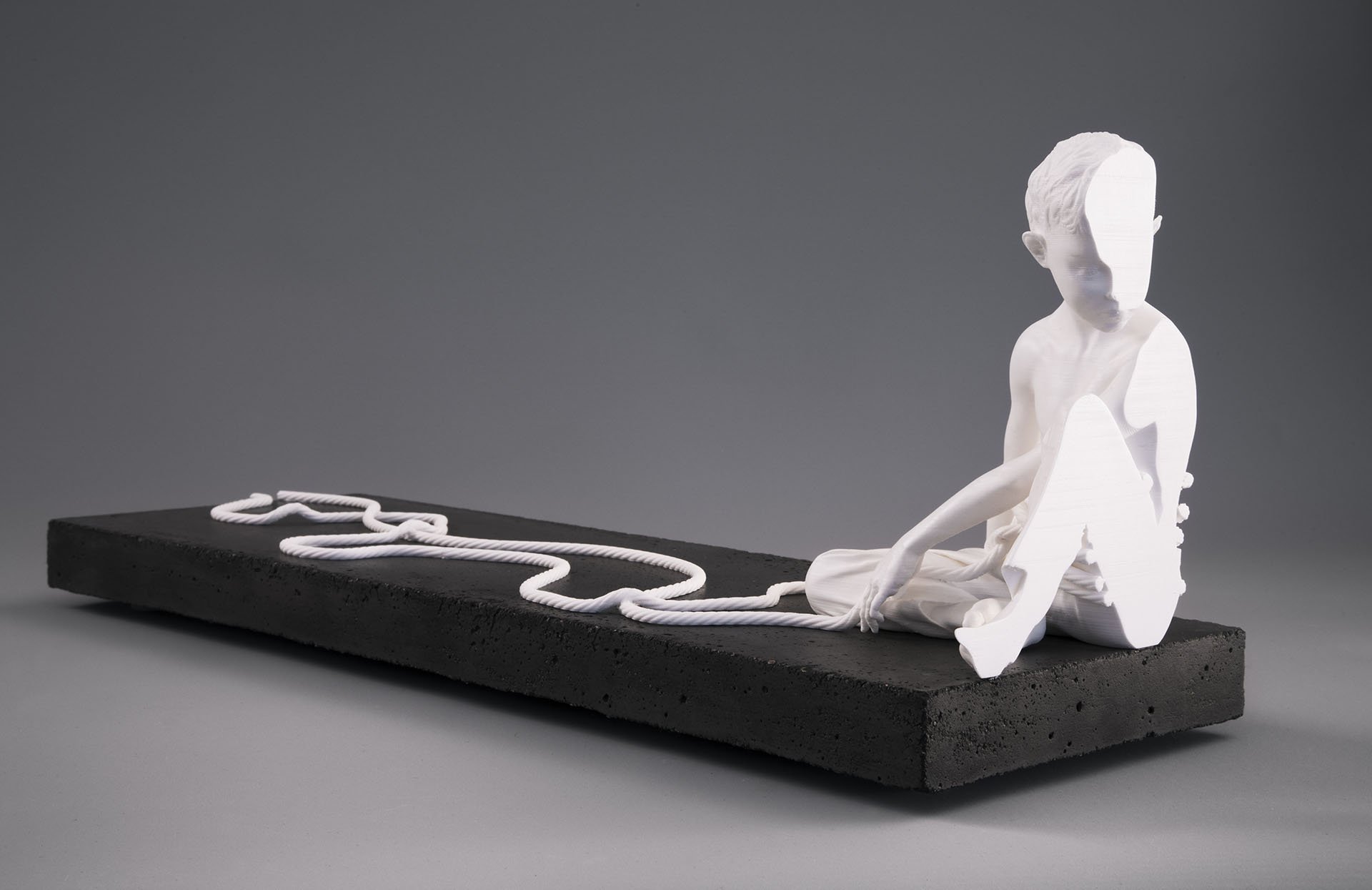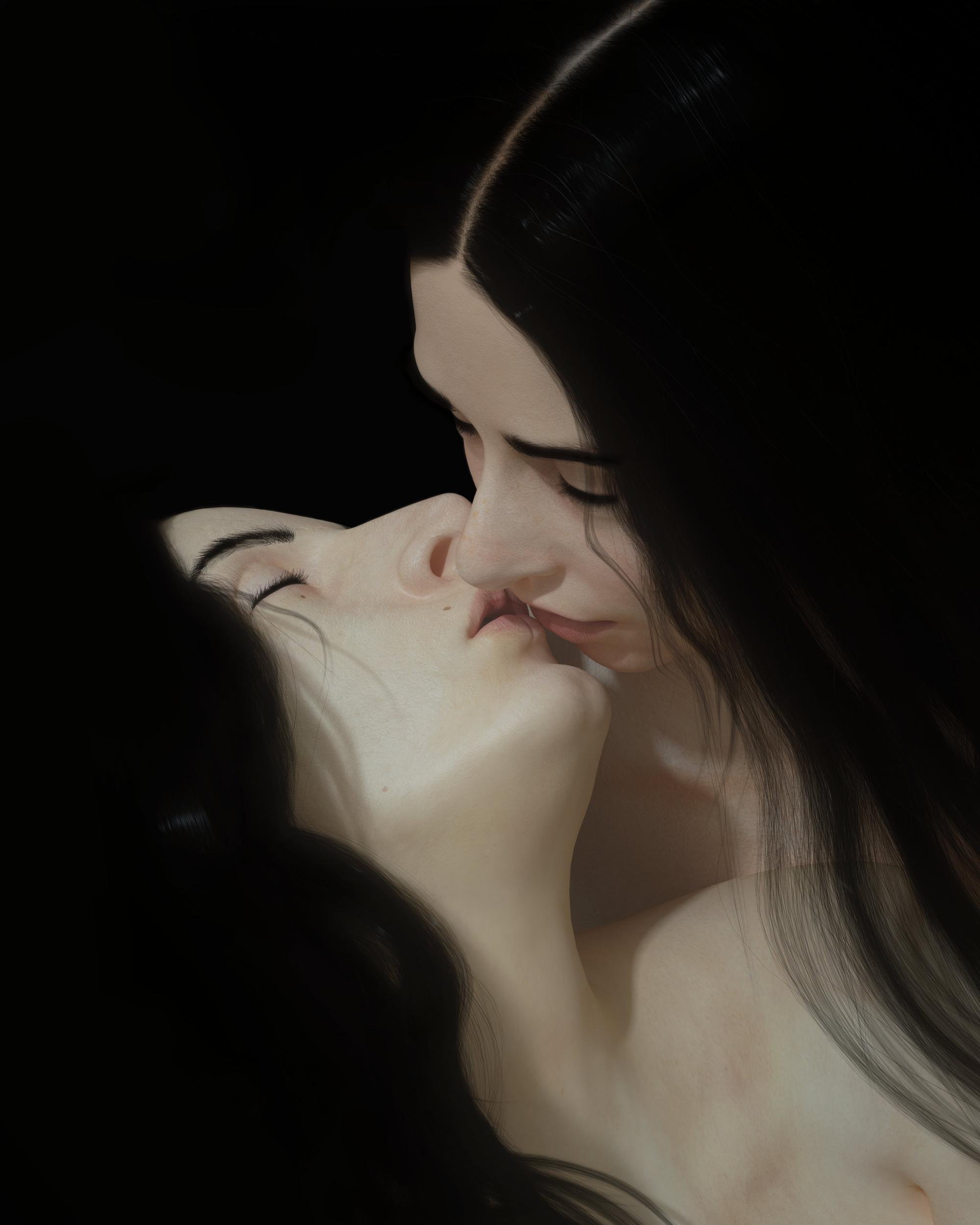Marc Hericher, an obsession with the tangible

Marc Hericher is one of those rare 3D artists who manages to reconcile a strong aesthetic style with a keen sense of conceptual thinking. As an artist and filmmaker, over the years he has developed a coherent, well-constructed body of work, whether through his films (ollo, Corpus, Absence) or still images coupled with 3D printing, as in his Another DNA series. Here, he talks to us about what brought him to 3D, his path and thoughts on 3D art, politics and the way he approaches his subjects.
Another DNA
Hello Marc. Could you tell us a bit about your background?
I started my studies quite early, right out of secondary school, where I joined a Roughman-Illustrator CAP. It's a profession that doesn't really exist any more, but it was a time when artists were needed to make press announcements, particularly to create mock-ups. I then went on to study at the Beaux-Arts, which introduced me to a wide variety of fields: sculpture, painting, film photography... It was a great learning experience, and I realized that there was a huge range of possibilities, whereas before I'd been more into illustration and comics, fields that had influenced me much more when I was young. After that, I went on to Arts-Déco, where I specialized in animation, a very multidisciplinary school where you work alongside students specializing in graphic design or set design, for example, which leads you to explore a huge range of techniques. When I came to this school, I thought I'd do cartoons, because my mode of expression was really drawing. I got into 3D because I thought it would give me more freedom in terms of animation. And in the end I stuck with it!
For me, 3D held the promise of enormous creative freedom. When I started in the 2000s, it was the beginning of the democratization of many artistic techniques and mediums, such as animation, which was previously unthinkable to do at home. This enabled me to approach more realistic and tangible worlds. I come from a painting background, and very quickly I was limited in what I wanted to express, especially in animation. It's also a fairly dangerous tool, because you have to set limits for yourself. You can spend a lot of time researching without necessarily thinking about what you want to do with it in the end.
You have a very interesting profile because you're a filmmaker, visual artist and sculptor all at once. Since you're active in all these mediums, what inspires you?
There are many things that inspired me, especially when I started drawing. I've always been fascinated by artists who transcend reality, who are realistic yet have a very strong symbolic charge. My drawing style is very much influenced by the Expressionist work of Egon Schiele, for example. Comics, too, with artists like Ashley Wood, who traumatized me a bit at the time, or more realistic artists like Ernest Pignon Ernest. Generally speaking, I was much more interested in the plastic, expressionist side of these works, as opposed to animated films like Akira or Ghost in the Shell, where it was the story that interested me. I really liked Mamoru Oshii's films, for example, where I sensed a strong philosophical subtext.
When I started animating, it led me to do something very tangible, very figurative, but with lots of ghosts hidden inside the image.
Marc Hericher
I'm also very fond of video art, like Bill Viola, or the Quay Brothers and Jan Švankmajer in animation. Their relationship to narrative has influenced me a lot, the fact that you don't necessarily need a classical structure of shots and reverse-shots, that you can make a film with a single camera movement, for example.
Another DNA
Another DNA
You have a very particular relationship with matter, particularly in the series Another DNA and your film Absence. It's not clear exactly what it is, whether it's clay, metal or flesh. For me, it's very close to the work of certain illustrators like Thomas Ott, for example, who has a very specific way of working with texture. Can you tell us more about this?
I approach materials as a whole. I'm interested first and foremost in revealing form, so I tend to work with homogeneous materials throughout the scene. This allows me to simplify the scene so I can concentrate on other things. For the material, I wanted to find textures that would follow and enhance the volume. I was also interested in being on the borderline between something soft and monstrous at the same time. I had to do a lot of research, but in the end I came up with this subject, which turned out to be very versatile.
In Another DNA, you mix pre-calculated images with this material, but also 3D printing with a much smoother finish. Why did you want to separate the two?
I didn't really try to reproduce the material of the images. What interests me when I explore a medium like 3D printing is precisely the possibility of exploring new things. I always ask myself what a new medium brings me, what makes it special. When I started 3D printing, I tried like everyone else to hide the plastic, with electrolytic metal plating for example, but I wasn't very comfortable with that. Casting wasn't accessible to me for financial reasons. I really like bronze and steel, but with bronze, for example, the material already has a strong connotation. We'd have lost the experimental aspect I liked and turned to something more decorative. That's why I thought I'd go for the immaculate white side of plastic. It's a much-hated material, and yet a very rich one. There's a way in which light diffuses through plastic which is fantastic, very close to human skin or marble for example, and the white color is also the best way to highlight the volume. This softness interested me, and I loved this way of exploring the material in a different, slightly more subtle way. Despite all this, I still wanted to get away from this immaculate white, and that's why I decided to work the pedestals in concrete, which is also one of the most hated materials in the world!
Another DNA
Another DNA
What has 3D printing brought to your work? Is it something you see as complementary to your pre-calculated visual work, or is it something completely different for you?
Maybe it's an obsession with the tangible, but at some point I needed to have a real trace of my work. 3D printing was a way of achieving this without denying the tools I used on an everyday basis. Sculpture also offered me a lot, particularly in terms of composition. Putting my sculptures on a pedestal would have turned them into something rather classical, and I wanted to add something more modern to that. And very strangely, I was inspired by what I loved about framing in cinema. I wondered how I could have a cut-out frame in my sculptures, and the pedestal enabled me to do just that, to delimit a volume frame in my pieces. That's why I cropped my sculptures, and I cropped them where it matters most, at the face.
I'm interested in extending the viewer's gaze, taking away one of the most important things so that they can make a mental journey and wonder about what's missing.
Marc Hericher
You've used 3D printing in one of your projects, Another DNA. Could you tell us about this one?
I'm obsessed with filiation and socio-cultural, genetic inheritance. These are themes that speak to me enormously. What interested me about this series is that it takes extremely simple premises and questions them in different ways, making it a series that could never really end, so deep are its possibilities. This DNA, this string that is both a link and a constraint, is precisely what I like to tackle in my work. There's always a contradiction, an ambiguity that can exist in these relationships, between support and constraint. It also allows me to work on relationships between characters that can be very surprising, while tackling political and philosophical issues such as determinism. If you take people's stories from the end, it's very easy to explain everything, but if you look at the chain reaction of causes, everything seems implausible.
Another DNA
Another DNA
Entre Chiens et loup
You talk about determinism, which is a very important theme in both sociology and philosophy, notably through the notion of free will. Did these themes come to you through any reading you might have done? Are there any thinkers who inspired you?
I don't read authors directly. I've always had a problem with words, but I draw a lot of inspiration from popularizations. Bourdieu obviously taught me quite a lot, or Günther Anders' Obsolescence of Man in philosophy, for example. I think that man's relationship with technology is also one of the issues I'd like to explore further.
Absence also has a very political angle. Can you tell us about this project?
The idea for Absence came to me in three phases. First there was my father, who every time he came to Paris was appalled by the number of homeless people on the streets, and would talk to me about it, even though it was a subject I didn't necessarily want to discuss. Later, I had this image of a homeless man collapsing to the ground and serving as a seat for people. I wrote the pitch very quickly, but the next day when I reread it I told myself that it wasn't the right approach, that people didn't behave that way. The principle was just gratuitous, purely aesthetic. What's more, having never been homeless, there was something absurd about the idea, a kind of bourgeois attitude.
Years later, it was while listening to the news that I found my approach. I couldn't stand the way they approached the subjects, especially the fact that they never got back to the roots of the problems, that they were only interested in the final part of the events. I wondered why these people who deal with information all the time always do it in the same way, without asking questions. The treatment of the homeless in winter is really typical of this pattern, which I was able to verify by looking at previous years' programs on the INA website. Journalists never question the socio-economic situation, the reason why homeless people are generated in our societies. And when they do, it's always for personal reasons - the loss of a job, a separation, psychological problems... The fundamental reason why there are homeless people is never dealt with in the media, and nobody is interested in it.
That's when I found my angle, talking about my experience as a spectator who's been fed news and empty media discourse. That's why I talk about all the characters that gravitate around the homeless person, rather than the homeless person himself. I don't put myself in his place, I don't know what he's going through, precisely because I can't know.
Watching your film, I was reminded of a story that took place a few years ago, in which a man died in the street in a moment of general indifference after collapsing. When you live in a big city like Paris, there's a kind of general indifference to extreme poverty, as if we're collectively avoiding seeing certain things.
This indifference you're talking about can be explained, not by saying that people are idiots, but by asking why people have this mental condition, why they react the way they do. There's a kind of depersonalization of individuals when there's a crowd. As soon as there are social relationships that are no longer on a human scale, a lot of mental processes come into play that prevent people from helping each other, even if they want to do so deep down.
For me, that's precisely what politics is all about: how we work together, not the people in parliament or those who govern us.
Marc Hericher
Absence
Absence
Absence
And that's what's so striking in Absence. You start by making these portraits of passers-by, and gradually you come to a critique of the media. The relationship is no longer singular and personal, but systematic and organizational. We can also feel this in the camera movement, which ends up revolving around the center of the table until all the faces merge into one. Can you tell us about the camera in your film?
In Absence, the script is very special, because I wrote the camera movements right from the beginning, and the camera is a character in its own right. Unlike other directors who consider the cut to be the basis of cinematographic grammar, for me it's the sequence shot. It gives weight to your images, it forces you to really pay attention to what you're looking at, it has something insistent about it. In my art, I also work a lot with the notion of tableaux, of living sculptures. I tend to favor frontal camera angles, which allow me to simplify and stylize the composition. With Absence, it's exactly the opposite, as the framing is always corrupted by the movement of the sequence shot. This required a great deal of research, in particular to make these fixed characters appear and disappear, and to organize transitions between these different tableaux without making them too long.
All transitional movements had to be useful from a symbolic point of view, or at least in terms of meaning.
Marc Hericher
Another DNA
Absence has a very particular relationship with time. There's already this organization of the film in relation to the seasons, but we're always moving in a kind of floating time, perhaps linked to the homeless man's distress, but which for me is close to the slow motion of a war film. You have the sensation of moving in the midst of events, while at the same time being distanced from them.
For me, the idea was to stop things in their tracks so that people could see them, to create a sense of time. By freezing people in a very symbolic action, there's something akin to a sculptor's approach. I even reworked some of the scenes I'd done for Another DNA, notably the one with the dogs. In fact, I changed the breed of the dogs, which in DNA were Dobermanns because they had their tails cut off, indicating an unnatural origin, whereas in Absence they look more like stray dogs.
Do you sculpt all your assets?
For a film, I can afford to take external elements like a car for example, a subject I find very difficult to do and which I'm not interested in modeling, but on the whole I sculpt and model everything. And that's the beauty of doing things yourself.
The interesting thing about 3D is that it allows us to intellectualize the tangible.
Marc Hericher
Hidden in an underground river
You mentioned in a previous interview that 3D was a toolbox for you, which I find interesting because 3D is precisely a tool that distinguishes the works it produces in each art form, whilst not possessing a form of its own. 3D sculptures are not considered to be "real" sculptures, 3D or animated films are not seen on the same level as live-action films... How do you feel about this?
There's a huge difference in treatment. It's a process that has been repeated throughout the history of art, with a new nuance emerging each time. At one point, I was very interested in what was happening in the early days of photography with the Pictorialists, who were trying to give their work an artistic cachet, making a lot of mistakes along the way, like reworking their prints with brushes, for example. There was an attitude that photography was art because art was used to make it, whereas photography itself is art because any expression can be art. In the case of 3D, there's something a bit dirty about it, and it's no doubt linked to the fact that it's a new technology that hasn't yet had time to be integrated. There's a nostalgia for practical special effects even if, paradoxically, everyone watches films with 3D.. All in all, there seems to be an impression of ease, whereas 3D hasn't made things any easier for artists.
I have the impression that the arrival of AI will put 3D back on the map, because there will be a demand for craftsmanship. People never think of 3D as a craft, even though it is. Most 3D artists are also craftsmen, the difference being that unlike other crafts, our tools are constantly evolving, making us dynamic artisans of a sort.
Thanks to Marc Hericher for taking the time to answer my questions.
You can follow his work on Behance, Instagram or on his website.


















